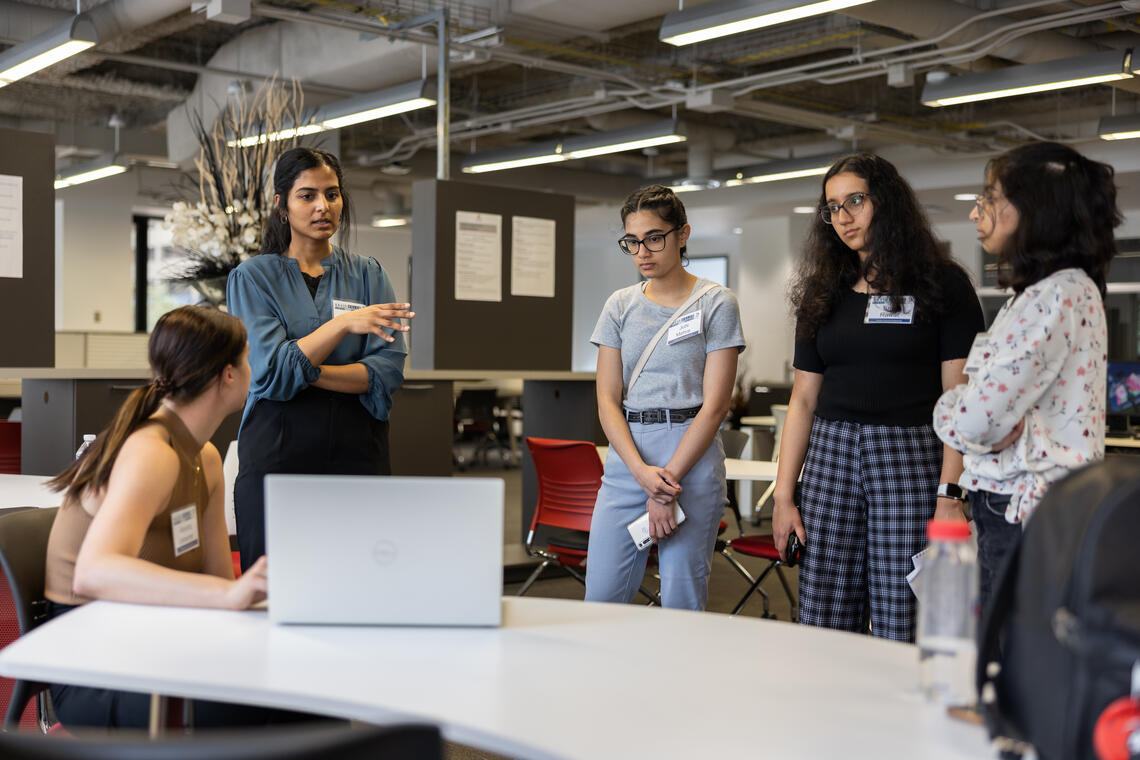Our research themes
Researchers in Electrical and Software Engineering are advancing fundamental artificial intelligence technologies and exploring a wide range of applications:
- Development and optimization of advanced AI architectures
- Large language models, federated learning and machine reasoning
- Ethical and trustworthy AI
- AI for engineering applications
- Impact of AI tools on engineering education
Researchers in this theme:
Mariana Pinheiro Bento, Steve Drew, Samira Ebrahimi Kahou, Yani Ioannou, Hadis Karimipour, Emily Marasco, Svetlana Yanushkevich, Roberto Medeiros de Souza

ESE faculty members and their research teams are developing new technologies to support many dimensions of healthcare:
- Optimizing user experiences in augmented, extended and virtual reality
- Assistive, accessible and inclusive technologies and data analytics
- Novel medical devices and measurement tools
- Fast, accurate and intelligent imaging and sensing
- Electronic health applications
Researchers in this theme:
Yaoping Hu, Kangsoo Kim, Diwakar Krishnamurthy, Geoffrey Messier, Kartikeya Murari, Hatem Abou-Zeid, Mariana Pinheiro Bento, Jay Carriere, Colin Dalton, Steve Drew, Samira Ebrahimi Kahou, Behrouz Far, Elise Fear, Ronnie de Souza Santos, Ethan MacDonald, Svetlana Yanushkevich, Roberto Medeiros de Souza

ESE researchers are tackling challenges in next generation communication systems, aiming to provide seamless and reliable access for 6G and beyond:
- Efficient transceiver technologies
- Intelligent networking, resource allocation, and computing frameworks
- Integrated communications and sensing
Researchers in this theme:
Hatem Abou-Zeid, Abraham Fapojuwo, Fadhel Ghannouchi, Mohamed Helaoui, Huaqing Wu, Qiang Ye

ESE research teams are developing technologies for electrification and tools to optimize integration into energy systems:
- Power electronics for next-generation devices and systems
- Optimizing energy systems for efficiency and sustainability
- Environmental, social, and fiscal impact of next generation and sustainable energy systems
Researchers in this theme:
Mostafa Farrokhabadi, Philippe Gray, Laleh Behjat, Jessica Bekker, Arne Dankers, Andy Knight, Hamidreza Zareipour

ESE researchers are developing next-generation technologies to support a wide range of communications, measurement and sensing systems:
- Radio frequency, microwave and optoelectronics devices, antennas and technologies
- Sensors from radio frequency to optical frequencies
- Quantum materials, devices and applications
- Microelectronics and integrated circuits
Researchers in this theme:
Zahra Abbasi, Leo Belostotski, Colin Dalton, Elise Fear, Fadhel Ghannouchi, Mohamed Helaoui, Erika Janitz, Brent Maundy, Kartikeya Murari, Michal Okoniewski

ESE research teams are developing technologies and design approaches to ensure the safety and security of a wide range of systems:
- Security for complex and critical systems ranging from consumer applications to critical infrastructure and defense
- IoT and Edge Computing Security
- Digital Privacy
- AI and Adversarial Machine Learning
- Design of hardware and software for security and usability
Researchers in this theme:
Hatem Abou-Zeid, Lorenzo De Carli, Yani Ioannou, Hadis Karimipour, Henry Leung, Abu-Bakarr Sesay, Sara Saeedi, Ben Tan, David Westwick, Svetlana Yaunshkevich

ESE researchers are developing advanced methods to integrate and analyze data from multiple sensing modalities:
- Advanced algorithms for sensor fusion and anomaly detection
- Biometrics
- Robotics
- System identification
Researchers in this theme:
Jay Carriere, Arne Dankers, Henry Leung, Sara Saeedi, David Westwick, Svetlana Yanushkevich

ESE research teams explore software development, expanding beyond technical development to user experiences and human factors:
- Software practices including user experiences, human factors, collaboration, teamwork, return on investment, and tools for automated development
- Understanding and mitigating bias in software systems and development
- All aspects of software development life cycle
Researchers in this theme:
Ahmad Abdel Latif, Ann Barcomb, Ronnie de Souza Santos, Lorenzo De Carli, Novarun Deb, Behrouz Far, Gouri Ginde, Diwakar Krishnamurthy, Yingxu Wang

ESE research is underpinned by several common themes. We aim to create inclusive technologies and the ecosystems required for development, implementation and ongoing evaluation. ESE researchers translate research findings out of their labs and into a variety of communities. ESE faculty members provide students with the tools to navigate our ever-changing world and develop cutting-edge approaches to engineering education:
- Equity, diversity, inclusion and accessibility in technology development, use and education
- Knowledge translation
- Entrepreneurship
- End-user engagement (industrial projects, transdisciplinary work)
- Open science
- Engineering education
- Integrated curriculum delivery (ILS)
- Digital literacy and AI/ML tools in education
- Creativity and innovation
Researchers in this theme:


